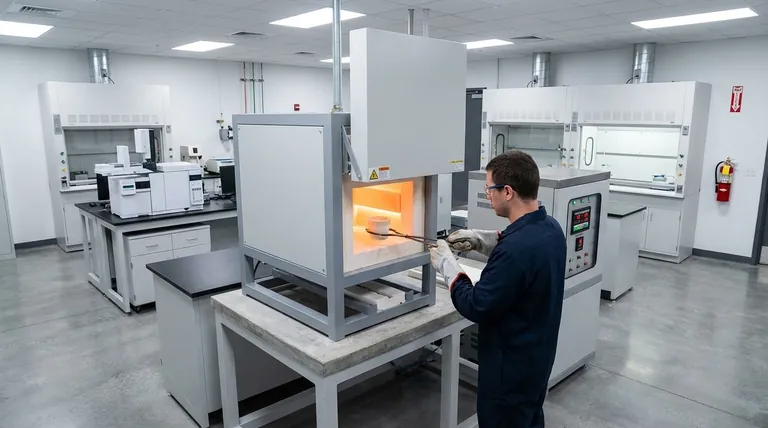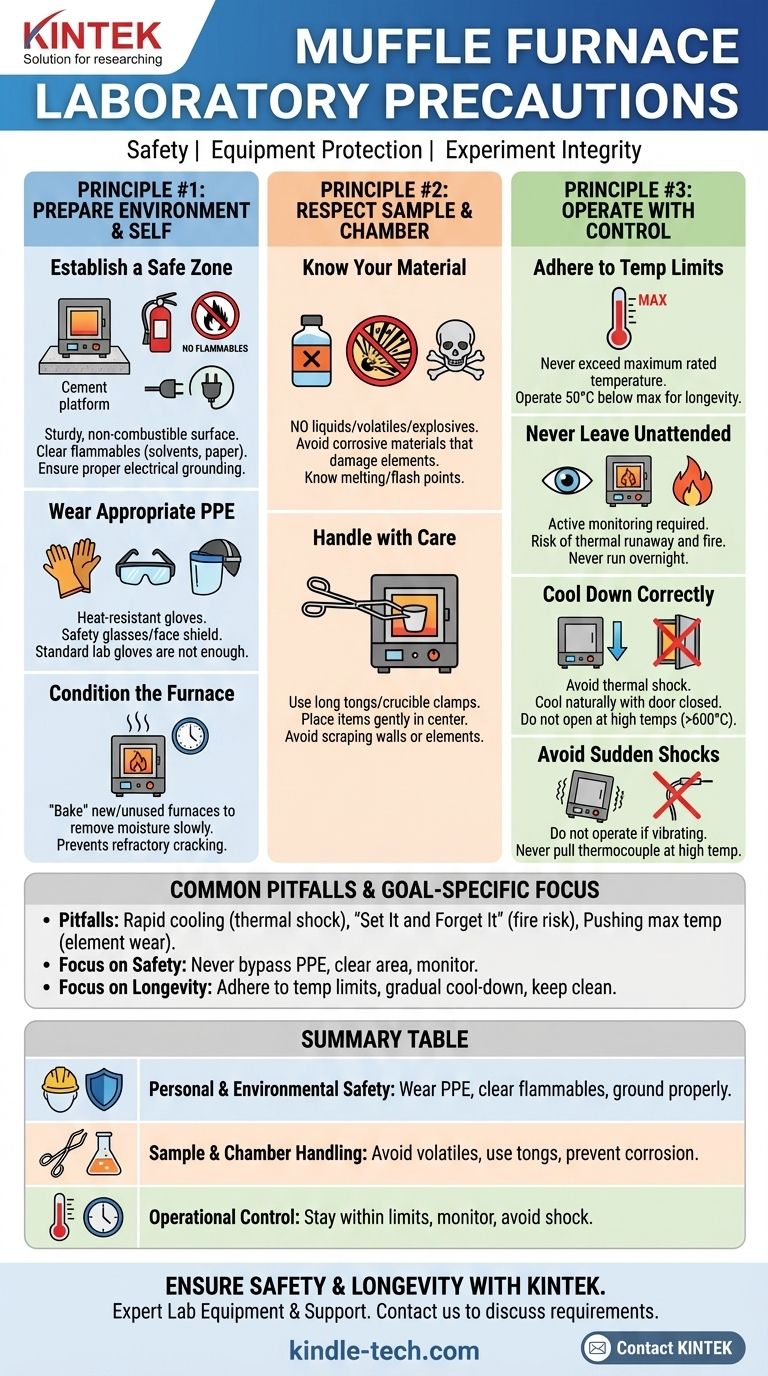Die wichtigsten Vorsichtsmaßnahmen für die Verwendung eines Muffelofens lassen sich in drei Kategorien einteilen: Verhinderung von Personenschäden, Schutz der Geräte vor Beschädigung und Gewährleistung der Integrität Ihres Experiments. Dies sind nicht nur Regeln, die befolgt werden müssen, sondern Prinzipien, die verstanden werden müssen, da deren Nichteinhaltung zu schweren Verbrennungen, Geräteausfällen, Bränden oder ruinierten Proben führen kann.
Ein Muffelofen ist ein Präzisionsinstrument, nicht nur ein einfacher Ofen. Sein sicherer und effektiver Betrieb hängt von einem systematischen Ansatz ab, der beginnt, bevor der Strom eingeschaltet wird, und lange nach dem Abkühlen endet.

Prinzip Nr. 1: Bereiten Sie Ihre Umgebung und sich selbst vor
Bevor Sie überhaupt daran denken, eine Probe zu erhitzen, müssen Sie sicherstellen, dass die Grundlage für die Sicherheit geschaffen ist. Dies beinhaltet die Sicherung des physischen Raums und die angemessene Ausrüstung des Bedieners.
Richten Sie eine sichere Zone ein
Ein Muffelofen erzeugt extreme Außentemperaturen und benötigt erhebliche elektrische Leistung. Er muss auf einer stabilen, ebenen und nicht brennbaren Oberfläche, wie z. B. einer speziellen Zementplattform, aufgestellt werden.
Der umliegende Bereich muss vollständig frei von brennbaren und entzündlichen Materialien sein. Dazu gehören Lösungsmittel, Papier und Putzlappen.
Stellen Sie sicher, dass der Ofen an einen ordnungsgemäß dimensionierten Stromkreis mit den richtigen Steckern, Buchsen und Sicherungen angeschlossen ist. Eine ordnungsgemäße Erdung ist nicht verhandelbar, um einen Stromschlag zu verhindern.
Tragen Sie die geeignete persönliche Schutzausrüstung (PSA)
Die Gefahr schwerer thermischer Verbrennungen ist hoch. Tragen Sie immer hitzebeständige Handschuhe und eine Schutzbrille oder einen Gesichtsschutz, wenn Sie Gegenstände in den Ofen geben oder daraus entnehmen.
Die Art des Handschuhs muss für die Arbeitstemperatur geeignet sein. Standard-Laboreinweghandschuhe bieten keinen Schutz vor der Strahlungswärme einer offenen Ofentür.
Bedingungen Sie den Ofen vor der Verwendung
Wenn der Ofen neu ist oder längere Zeit nicht benutzt wurde, hat er Feuchtigkeit in seiner feuerfesten Auskleidung aufgenommen. Diese Feuchtigkeit muss langsam ausgetrieben werden, um Schäden zu vermeiden.
Dies geschieht durch „Einbrennen“ des Ofens: Er wird bei niedriger Temperatur über mehrere Stunden erhitzt, bevor die Temperatur schrittweise erhöht wird. Wenn dies nicht geschieht, kann sich Dampf schnell im feuerfesten Material ausdehnen, was zu Rissen führen kann.
Prinzip Nr. 2: Respektieren Sie die Probe und die Kammer
Was Sie in den Ofen legen und wie Sie es hineinlegen, wirkt sich direkt auf die Sicherheit und die Lebensdauer des Geräts aus.
Kennen Sie Ihr Material
Geben Sie niemals Flüssigkeiten, flüchtige Stoffe oder explosive Materialien in den Ofenraum. Schnelles Erhitzen kann zu unkontrollierter Verdampfung oder Entzündung führen.
Proben, die Fette, Öle oder bestimmte Kunststoffe enthalten, können beim Erhitzen korrosive Gase freisetzen. Diese Gase greifen die Oberfläche der Heizelemente an und zerstören sie, wodurch deren Lebensdauer drastisch verkürzt wird. Wenn Sie solche Materialien erhitzen müssen, verwenden Sie einen verschlossenen Behälter mit ordnungsgemäßer Belüftung.
Kennen Sie die Schmelz- und Flammpunkte aller Gegenstände, die Sie in die Kammer geben, um unerwartete Reaktionen zu vermeiden.
Gehen Sie vorsichtig vor
Verwenden Sie immer lange Zangen oder Tiegelklemmen, um Proben ein- und auszuladen. Dadurch bleiben Ihre Hände von der intensiven Hitze fern.
Legen Sie die Gegenstände vorsichtig in die Mitte der Kammer. Fallenlassen oder Kratzen der Gegenstände an den Kammerwänden oder Heizelementen kann sofortige und kostspielige Schäden verursachen.
Prinzip Nr. 3: Bedienen Sie mit bewusster Kontrolle
Ein Muffelofen ist kein Gerät, das man „einstellt und vergisst“. Er erfordert aktive Überwachung und eine disziplinierte Betriebssequenz.
Halten Sie sich an die Temperaturgrenzen
Betreiben Sie den Ofen niemals über seine maximal zulässige Temperatur hinaus. Dies führt zum Durchbrennen der Heizelemente und kann zu einem katastrophalen Ausfall führen.
Für den regelmäßigen Gebrauch und um die Lebensdauer der Heizelemente zu maximieren, ist es bewährte Praxis, bei mindestens 50 °C unter der maximalen Temperatur zu arbeiten.
Lassen Sie ihn niemals unbeaufsichtigt
Ein in Betrieb befindlicher Ofen muss überwacht werden. Steuerungssysteme können ausfallen und Thermoelemente können fehlerhaft werden, was zu einer thermischen Durchgehensreaktion führt, die eine erhebliche Brandgefahr darstellt. Betreiben Sie einen Ofen niemals über Nacht unbeaufsichtigt.
Wenn Sie Anomalien wie ungewöhnliche Geräusche, Rauch oder eine Temperaturanzeige, die nicht mit dem Sollwert übereinstimmt, feststellen, schalten Sie die Stromversorgung sofort ab und lassen Sie das Gerät überprüfen.
Richtig abkühlen
Öffnen Sie niemals die Ofentür bei hohen Temperaturen (z. B. über 600 °C), um ihn schneller abzukühlen. Der plötzliche Zustrom kühler Luft erzeugt thermischen Schock, der die feuerfeste Auskleidung des Ofens reißen und möglicherweise Ihre Probe zersplittern lassen kann.
Schalten Sie immer den Strom aus und lassen Sie den Ofen bei geschlossener Tür auf natürliche Weise abkühlen.
Vermeiden Sie plötzliche Stöße
Betreiben Sie den Ofen nicht, wenn er vibriert. Wichtiger noch: Ziehen Sie niemals das Thermoelement aus seiner Fassung, wenn der Ofen eine hohe Temperatur hat. Die schnelle Temperaturänderung kann dazu führen, dass die schützende Keramikummantelung zersplittert.
Verständnis der häufigsten Fallstricke
Neue Benutzer sind oft versucht, Abkürzungen zu nehmen, die die Sicherheit und die Langlebigkeit der Geräte zugunsten der Geschwindigkeit beeinträchtigen.
Die Versuchung der schnellen Abkühlung
Der Wunsch, schnell an eine Probe zu gelangen, ist stark, aber das Öffnen der Tür eines heißen Ofens ist eine der häufigsten Ursachen für dauerhafte Schäden. Die eingesparte Zeit ist den Austausch der Ofenauskleidung nicht wert.
Der Trugschluss „Einstellen und Vergessen“
Den Ofen wie einen Haushaltsbackofen zu behandeln, ist ein kritischer Fehler. Seine Leistungs- und Temperaturfähigkeiten erfordern Respekt. Ein einfacher Controller-Ausfall kann einen unbeaufsichtigten Ofen in eine unkontrollierte Brandquelle verwandeln.
Betrieb an der maximalen Temperatur
Obwohl der Ofen für eine Höchsttemperatur ausgelegt ist, ist der ständige Betrieb an dieser Grenze so, als würde man den Motor eines Autos am roten Bereich betreiben. Es beschleunigt den Verschleiß der wichtigsten Komponenten – der Heizelemente – drastisch.
Anwendung dieser Vorsichtsmaßnahmen auf Ihr Ziel
Ihre spezifischen Prioritäten bestimmen, welchen Vorsichtsmaßnahmen die meiste Aufmerksamkeit gewidmet werden muss.
- Wenn Ihr Hauptaugenmerk auf der Bedienersicherheit liegt: Umgehen Sie niemals die PSA, stellen Sie immer sicher, dass der Bereich frei von brennbaren Stoffen ist, und betreiben Sie den Ofen niemals unbeaufsichtigt.
- Wenn Ihr Hauptaugenmerk auf der Langlebigkeit der Geräte liegt: Halten Sie sich strikt an die Temperaturgrenzen, führen Sie immer eine schrittweise Abkühlung durch und halten Sie die Kammer frei von korrosiven Rückständen.
- Wenn Ihr Hauptaugenmerk auf der experimentellen Genauigkeit liegt: Konditionieren Sie einen neuen oder lange unbenutzten Ofen immer, um Feuchtigkeit auszutreiben, und stellen Sie sicher, dass Ihre Proben frei von Verunreinigungen sind, die ausgasen und Ihren Prozess stören könnten.
Die Beherrschung der Verwendung eines Muffelofens wird durch Disziplin und einen tiefen Respekt vor seiner Leistung erreicht.
Zusammenfassungstabelle:
| Kategorie der Vorsichtsmaßnahme | Wesentliche Maßnahmen |
|---|---|
| Persönliche & Umweltsicherheit | Tragen Sie hitzebeständige PSA, entfernen Sie brennbare Materialien, stellen Sie eine ordnungsgemäße Erdung sicher. |
| Umgang mit Probe & Kammer | Vermeiden Sie flüchtige Materialien, verwenden Sie die richtigen Zangen, verhindern Sie die Freisetzung korrosiver Gase. |
| Betriebskontrolle | Überschreiten Sie niemals die Temperaturgrenzen, vermeiden Sie unbeaufsichtigten Betrieb, verhindern Sie thermischen Schock während des Abkühlens. |
Gewährleisten Sie die Sicherheit und Langlebigkeit Ihrer Laborgeräte. Die ordnungsgemäße Verwendung eines Muffelofens ist entscheidend für den Schutz Ihres Personals und Ihrer Forschungsintegrität. KINTEK ist spezialisiert auf hochwertige Laborgeräte und Verbrauchsmaterialien und bedient alle Ihre Laboranforderungen. Unsere Experten helfen Ihnen bei der Auswahl des richtigen Ofens und dem Verständnis der besten Praktiken für einen sicheren Betrieb.
Kontaktieren Sie KINTEK noch heute, um Ihre spezifischen Anforderungen zu besprechen und sicherzustellen, dass Ihr Labor sicher und effizient arbeitet.
Visuelle Anleitung

Ähnliche Produkte
- Labor-Muffelofen-Bodenhub-Muffelofen
- 1400℃ Muffelofen für Labor
- 1700℃ Muffelofen für Labor
- 1800℃ Muffelofen für Labor
- 1400℃ Labor-Quarzrohr-Ofen mit Aluminiumoxidrohr-Röhrenofen
Andere fragen auch
- Wie stellen Sie die Temperatur bei einem Muffelofen ein? Beherrschen Sie die präzise Steuerung für Ihr Labor
- Wie heiß ist ein Muffelofen in Celsius? Ein Leitfaden für Temperaturbereiche von 800°C bis 1800°C
- Was ist der Zweck eines Muffelofens? Erreichen Sie eine reine, kontaminationsfreie Hochtemperaturheizung
- Was ist das Prinzip eines Muffelofens? Erzielen Sie reine, präzise Hochtemperaturheizung
- Was ist die Mindesttemperatur für einen Muffelofen? Das Verständnis seines High-Tech-Designs



















